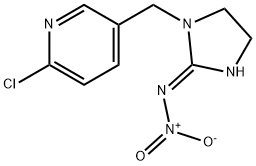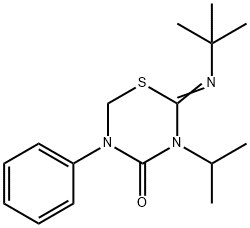ImidaclopridSolutioninEthanol , 100 μg/mlinethanol, uncertainty 3%
CAS NO.:
Empirical Formula: C9H10ClN5O2
Molecular Weight: 255.66
MDL number: MFCD01721131
EINECS: 200-835-2
| Pack Size | Price | Stock | Quantity |
| 1.2ml | RMB63.20 | In Stock |
|
| others | Enquire |
PRODUCT Properties
| Melting point: | 144°C |
| Boiling point: | 93.5°C (rough estimate) |
| Density | 1.54 |
| vapor pressure | 2 x 10-7 |
| refractive index | 1.5790 (estimate) |
| Flash point: | 2 °C |
| storage temp. | 0-6°C |
| solubility | DMSO:75.5(Max Conc. mg/mL);295.31(Max Conc. mM) Ethanol:2.0(Max Conc. mg/mL);7.82(Max Conc. mM) Water:1.0(Max Conc. mg/mL);3.91(Max Conc. mM) |
| form | Solid |
| pka | 7.16±0.20(Predicted) |
| color | White to off-white |
| Water Solubility | 0.061 g/100mL at 20 ºC |
| LogP | 0.7 at 24℃ |
| CAS DataBase Reference | 138261-41-3(CAS DataBase Reference) |
| EPA Substance Registry System | Imidacloprid (138261-41-3) |
Description and Uses
Imidacloprid is the active ingredient in AdvantageTM used to control fleas in dogs and cats (HSDB, 2006). Clothianidin is the major metabolite of thiamethoxam and both compounds are registered for use as insecticides. Widespread use increased greatly in the 1990s as alternatives to organophosphosphorus and carbamate insecticides because of their much lower mammalian toxicity and resistance developed to other pesticides. Imidacloprid has become the most widespread insecticide used in the world.
A neonicotinoid; the active ingredient in certain neuro-active insecticides. Reports show that when exposed to neonicotinid pesticides honeybees have probelms returnign home after foraging and bumble bee colonies grow poorly and produce fewer queens.
Safety
| Symbol(GHS) |   GHS07,GHS09 |
| Signal word | Warning |
| Hazard statements | H302-H410 |
| Precautionary statements | P273-P301+P312+P330 |
| Hazard Codes | N,Xn,F |
| Risk Statements | 11-20/21/22-36-22-20/22 |
| Safety Statements | 26-36-22-36/37-16-46-44 |
| RIDADR | UN 2588 |
| WGK Germany | 2 |
| RTECS | NJ0560000 |
| HazardClass | 6.1(b) |
| PackingGroup | III |
| HS Code | 29333990 |
| Hazardous Substances Data | 138261-41-3(Hazardous Substances Data) |


